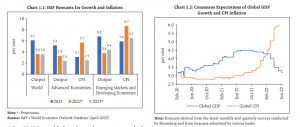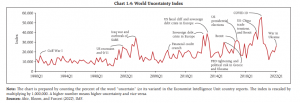
The gross non-performing assets (GNPAs) of the commercial banks have come down to a six-year low of 5.9% this March. This is definitely good news for banks at a time when worries of a global recession, the rupee free fall, and high inflation abound. This is the lowest NPA level since 2016, when bad loans in the Indian banking system had soared after the RBI conducted an asset quality review. The decrease in NPAs shows that the financial sector is resilient and has remained largely unscathed in the wake of the coronavirus pandemic.
One cannot ignore the fact that even at the lowest levels in six years, the NPA level of the Indian banking system is much higher than other large economies. In fact, barring Russia, every other major economy has lower NPAs than in India, says a report by CareEdge Ratings. In developed countries including China, NPAs are below 3%. This raises questions regarding how resilient the Indian banks would be in the face of a looming global recession.
READ ALSO | Govt, RBI must brace for the looming NPA crisis
What are NPAs?
Asset, in financial parlance, means something that generates income. A non performing asset (NPA) is a term used by financial institutions to classify a loan or advance on which the principal or interest payment has remained overdue for a period of 90 days or more. However, some lenders also take into account a shorter duration to consider a loan or advance past due. In India, banks are mandated to classify NPAs further into substandard, doubtful and loss assets.
Substandard assets are assets which have remained NPA for a period less than or equal to 12 months. An asset is classified doubtful if it has remained in the substandard category for a period of 12 months. Loss assets, according to the Reserve Bank of India, are ones that are considered uncollectible or of such little value that their continuance as a bankable asset is not warranted, but there may be some salvage or recovery value.
What do NPAs say about the health of a bank?
Gross NPA is the total value of non-performing assets of the bank and tells the amount of loans that the bank isn’t earning any money on. Since interest paid by the borrowers is the primary source of income for a bank, defaults in these payments mean that the said bank might not be in the pink of health.


Banks are considered the safest financial institutions in India. But when large banks happen to have scams or failures, they raise serious concerns about the safety of funds as it reflects on the health of a bank. A higher GNPA means the bank has poor quality of assets.
Rising NPAs can impact the strength of a bank and can undermine its image, making the public lose trust in banks. The customers may withdraw their deposits causing liquidity issues for banks. The lack of liquidity further means that the bank is rendered incapable of lending for productive activities in the economy.
The ongoing Russia-Ukraine war has dented the fragile recovery of the global economy from the crisis triggered by coronavirus pandemic. This has become a serious concern for India as the rupee continues to fall against the dollar. The consumer price inflation has hit the highest in several decades, while wholesale price inflation has touched unprecedented levels. Experts around the globe are dreading a slowdown in the global economy.
READ ALSO | Positives in RBI report no defence against a recession
What does RBI say about current state of banks?
In its recently released Financial Stability Report, the apex bank said that the country’s banks have bolstered their risk absorbing capacity as gross non-performing assets declined to their lowest level in six years. While some segments as well as non-banking financial companies may be vulnerable to liquidity shocks, other banks are poised to comply with minimum capital adequacy norms even in a severe stress scenario.
The RBI remains hopeful that the scheduled commercial banks will remain resilient despite adverse macroeconomic circumstances. But the public sector banks are at risk of eroding financial strength due to substantial unrealised losses on their books at the beginning of the interest rate tightening cycle. The central bank says banks as well as non-banking institutions have sufficient capital buffers to withstand sudden shocks even while India is witnessing spill overs from current global circumstances.
Prachi Gupta is an Assistant Editor with Policy Circle. She is a post graduate in English Literature from Lady Shri Ram College For Women, Delhi University. Prachi started her career as a correspondent with financialexpress.com. She specialises in policy impact studies.

